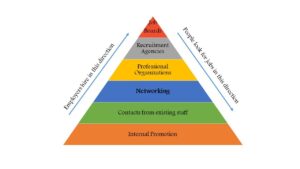Ontario’s labour shortage in 2025 looks different than it did a couple of years ago. Unemployment has edged up, vacancies have cooled from pandemic-era peaks, and yet many employers still struggle to find the right people—especially in health care, skilled trades, logistics, and tech-adjacent roles. In this article, we break down the key stats Ontario employers should know in 2025, then translate them into practical hiring and retention moves you can put to work now.
The big picture: demand cooled, gaps persist
After several years of intense hiring, the labour market moderated through 2024 and into 2025. Ontario added jobs in 2024, but labour force growth outpaced hiring, pushing the annual unemployment rate to 7.0% in 2024 and easing wage pressure in some sectors. At the same time, employers continue to report hard-to-fill roles where certification, experience, or shift requirements narrow the candidate pool.
Early 2025 data shows a mixed story: job vacancies are lower than their 2022 highs, yet hiring bottlenecks remain where demographic trends, credential rules, or location-specific constraints limit supply. Statistics Canada’s Job Vacancy and Wage Survey indicates vacancy levels trended down through 2024 and into 2025 as employers adjusted hiring plans—one reason you may see more applicants overall but fewer truly qualified fits for specialised roles.
Key stats Ontario employers should watch in 2025
1) Unemployment and participation
- Unemployment rose to 7.0% in 2024 (annual), up from 5.6% in 2023, reflecting labour force growth outpacing job creation. Core-age workers still saw gains, while youth and older male workers faced pressure.
- Quarterly provincial reporting in 2025 shows a softer employment environment and slowing economic momentum—important context when planning headcount and compensation.
2) Job vacancies and where shortages persist
- Vacancies declined ~24% in 2024 versus 2023, but shortages remain in health care, construction, and specific technical roles. Employers in logistics/warehousing also report ongoing competition for reliable shift-based talent.
- The monthly provincial vacancy rate has eased compared with 2022–2023 but remains uneven across industries and regions, reinforcing the need for local, role-by-role recruitment strategies.
3) Wages and cost pressures
- Average hourly wages grew 5.2% in 2024 to $36.44. Wage growth has cooled from the peak but still outpaced inflation, especially in many in-demand occupations. Budget for targeted increases where market data shows ongoing scarcity.
- For budgeting new roles, remember the full loaded cost (CPP/EI, WSIB/EHT, vacation/public holiday pay, onboarding, and turnover). Our recent breakdown of the true cost to hire in Ontario can help you model offers and approvals more accurately. (See: how much it really costs to hire in Ontario).
4) Policy and immigration signals
- Ontario is continuing to use the Ontario Immigrant Nominee Program (OINP) to address skill gaps. Employers using OINP pathways should monitor 2025 updates and the Employer Portal requirements.
- Federally, the 2025–2027 immigration levels plan maintains a high share of economic admissions, signalling continued reliance on immigration to support labour supply.
What “labour shortage” really means in 2025
The phrase “labour shortage” can be misleading. Province-wide, there are more applicants per posting than at the 2022 peak. But at the job level, the challenges are still real:
- Skill specificity: roles requiring trade certification, clinical credentials, or niche software expertise.
- Shift and location: evening/night shifts, split shifts, or sites outside major transit corridors.
- Experience thresholds: employers seeking “plug-and-play” performers with deep domain knowledge.
- Reputation and retention: candidates ask pointed questions about culture, growth, and pay transparency.
In short: labour availability improved in general, but the match between roles and qualified workers remains tight in priority sectors.
Sector snapshots for Ontario employers
Health care & community support
- Persistent vacancies in nursing, PSWs, and allied health keep competition high. Employers win by shortening hiring steps, improving onboarding, and offering predictable schedules. Provincial reporting shows health care remains a large source of public-sector job growth.
Construction & skilled trades
- Demand fluctuated with interest rates and project timing, and 2024 saw lower construction employment. Yet certified electricians, HVAC, millwrights, and heavy equipment operators are still scarce in many regions. Use the new “as-of-right” mobility framework to consider talent from other provinces and reduce time-to-hire. (See: Ontario’s new “as-of-right” framework)
Logistics, warehousing & manufacturing
- Vacancies eased, but absenteeism and shift preferences create scheduling gaps. Employers who offer stable shifts, real advancement paths, and attendance incentives reduce churn and hiring costs faster than those focusing on hourly wage alone. 2025 economic indicators suggest cautious demand planning—build flexible staffing models.
Professional & technical services
- 2024 saw robust growth in professional services. In 2025, demand is more selective: employers prioritise T-shaped talent with domain depth plus cross-functional skills. Tighten role definitions and invest in upskilling to expand your candidate pool.
Compliance changes that affect your hiring funnel
Legislative updates continue to shape how you recruit and retain:
- Written information requirements for Ontario employers with 25+ staff now require specific onboarding disclosures—build these into your offer and day-one processes. (Read: new written information requirements for Ontario employers).
- Pay transparency rules coming by January 2026 will formalise salary ranges in postings—many employers are moving early to stay competitive and boost apply rates. (See: Ontario pay transparency rules coming Jan 2026).
- Ethical AI guidance is tightening: if you use screening or assessment tools, align with the HRPA’s guidance and document vendor due diligence. (Read: HRPA’s guide to using AI in hiring).
Hiring strategy: what works now (and what to stop doing)
1) Re-scope roles to widen your candidate pool
Break “unicorn” job descriptions into must-have vs nice-to-have skills. Where certification isn’t required, accept adjacent experience and invest in first-90-day training. Align with OINP-friendly NOCs where appropriate.
2) Speed wins: compress your time-to-offer
In scarce roles, aim for 7–10 days from first contact to offer. Pre-book interview slots, streamline approvals, and use structured interviews to reduce bias and improve decision speed. If you haven’t already, map your process against Bill 192/“Working for Workers” changes and AI disclosures. (See: what employers need to know now).
3) Lead with salary range and the “why”
Pay transparency is becoming table stakes and improves apply rates. Include benefits, shift premiums, growth paths, and realistic timelines. Link to team pages or psychological safety commitments to differentiate your culture. (Read: Is your workplace truly safe?).
4) Build a bench with flexible models
Use contract-to-hire, seasonal, and contingent pools to cover surges without over-committing fixed costs. This is especially effective in warehousing, events, and production. When demand stabilises, convert your top performers quickly.
5) Plug retention leaks before you post the job
Exit interviews often point to supervisor relationships, schedules, and recognition. Fix these at the source. If “quiet quitting” hit your teams, reset goals, career conversations, and manager training. (See: employee engagement strategies).
Regional tactics: think hyper-local
Ontario’s labour market isn’t one market. Shortages can be street-by-street issues tied to transit, housing, and employer clusters. If you operate outside the GTA or across multiple hubs, localise:
- Post in community boards and niche groups near your sites.
- Offer commute support (parking stipends, shuttle options, carpool matching) for off-shift roles.
- Partner with nearby training providers for “learn-and-earn” pathways, especially in trades and advanced manufacturing.
Not sure where to start? Our Ontario locations network connects you with on-the-ground recruiters who know the talent flows in your city. (Explore: Divino’s Ontario locations)
Budgeting for 2025: align headcount, wages, and risk
- Model offers on total cost, not just base pay. Use realistic assumptions for overtime, absenteeism, and the ramp-up period. (Helpful guide: the cost to hire a worker in Ontario).
- Expect moderate wage growth in tight roles and normalisation in others. Keep a market tracker by role family so you can adjust ranges quarterly, not yearly.
- Build contingency plans around trade and macro headlines that can move hiring up or down in export-exposed sectors. Provincial and national policy moves (tariffs, incentives, major investments) can quickly shift demand for specific skills—stay close to monthly labour market reports.
Practical checklist: fill hard-to-staff roles faster
- Define success in the first 90 days (skills, outputs, schedule) and hire to that plan.
- Shorten your funnel: two interviews max, skills test only if it predicts performance.
- Publish the range and growth path; anticipate 2026 transparency rules.
- Recruit beyond your backyard: leverage inter-provincial mobility and OINP channels.
- Stack incentives that matter: stable shifts, supervisor training, micro-bonuses tied to attendance and safety.
- Market your culture: emphasise psychological safety, mentorship, and learning access. (Read: workplace psychological safety guide).
- Use a partner when roles are repetitive, high-volume, or require compliance-heavy onboarding.
Where to watch the data (and why it matters)
If you’re planning 2025–26 headcount, keep an eye on:
- Ontario Labour Market monthly reports for unemployment, participation, and sector trends.
- Statistics Canada job vacancy tables for vacancy rates and offered wages by province.
- FAO Ontario reports for wage growth, sectoral shifts, and macro outlook.
- OINP updates if you recruit through immigration pathways.
Tie your recruiting calendar to these releases so you can adjust postings, ranges, and sourcing channels in real time.
How Divino can help—fast
When time-to-fill slips or turnover spikes, Ontario employers turn to Divino to stabilise staffing, run compliant payroll, and improve retention with practical, on-the-floor fixes. Explore our services and local support network here: HR, Staffing & Payroll in Ontario.
Ready to steady your hiring?
Book a Free Staffing Consultation with Divino or Schedule Your HR Planning Call Today to align roles, budgets, and timelines with the real 2025 market.







